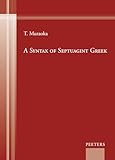A syntax of Septuagint Greek / T. Muraoka.
Material type: TextPublication details: Leuven ; Bristol, CT : Peeters, c2016.Description: lxxiii, 904 pages : 29 cmISBN:
TextPublication details: Leuven ; Bristol, CT : Peeters, c2016.Description: lxxiii, 904 pages : 29 cmISBN: - 9789042933163
- 904293316X
- PA751 .M87 2016
 Reference Book
Reference Book
| Current library | Collection | Call number | Vol info | Copy number | Status | Date due | Barcode | |
|---|---|---|---|---|---|---|---|---|
| Judith Thomas Library Reference Books | Reference Shelves | PA 751 .M87 2016 (Browse shelf(Opens below)) | AUA25526 | Not for loan | AUA25526 | |||
| Judith Thomas Library Reference Books | Reference Shelves | PA 751 .M87 2016 (Browse shelf(Opens below)) | AUA25527 | 2 | Not for loan | AUA25527 |
Includes bibliographical references (pages lv-lxxiii), appendices, and indexes.
This is the first ever comprehensive analysis of the morphosyntax and syntax of Septuagint Greek. The work is based on the most up-to-date editions of the Septuagint. The so-called Antiochene version of Samuel, Kings, and Chronicles as well as Judges has been studied. Though this is a synchronic grammar, and though not systematic, comparison with Classical Greek, the Greek of contemporary literature of the Hellenistic-Roman period, papyri and epigraphical data, and New Testament Greek has often been undertaken. Even when analysing translated documents of the Septuagint, the perspective is basically that of its readers. However, attempts were made to determine in what ways and to what extent the structure of the Semitic source languages may have influenced the selection of this or that particular construction by translators. At many places it is demonstrated and illustrated how an analysis of the morphosyntax and syntax can illuminate our general interpretation of the Septuagint text.
